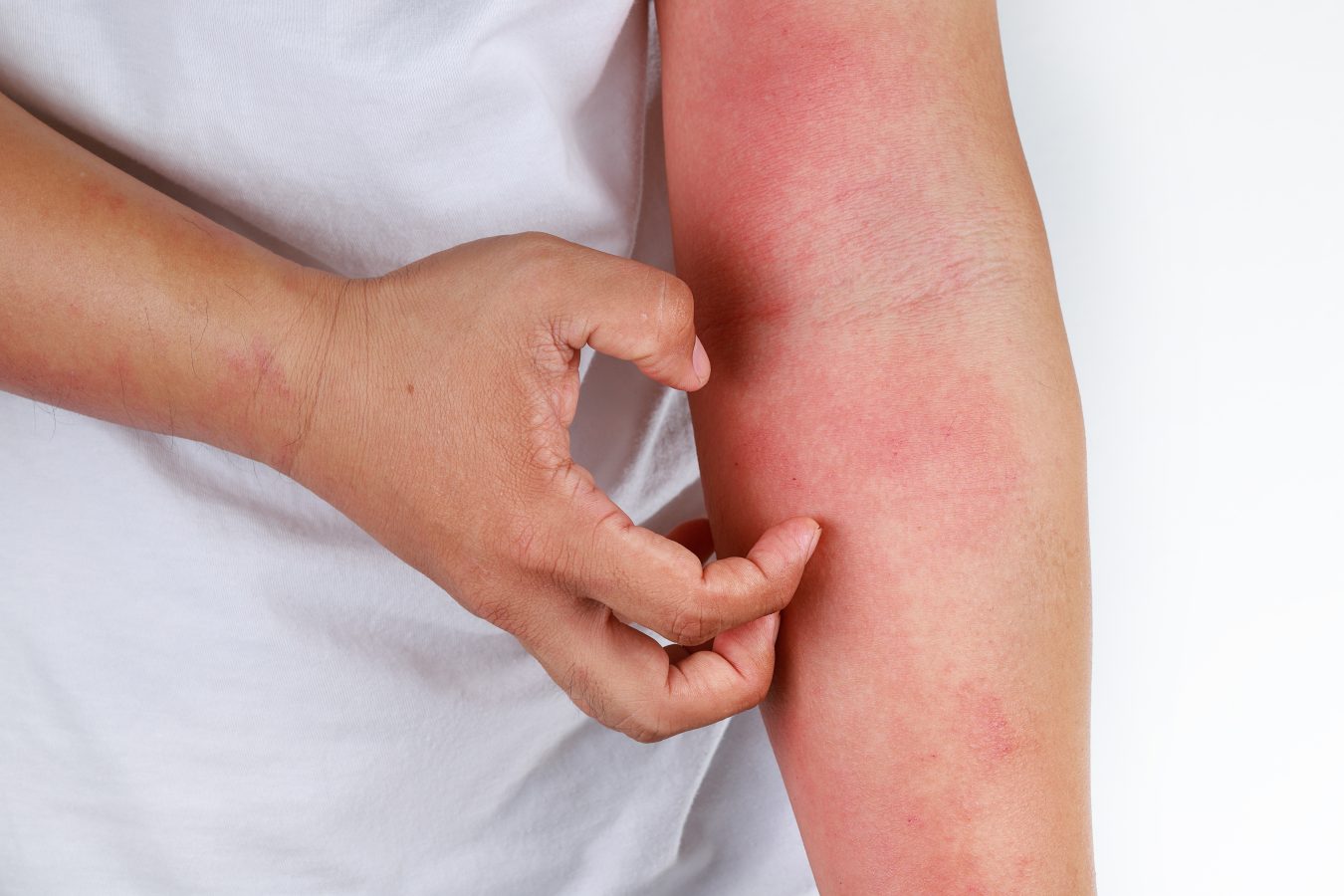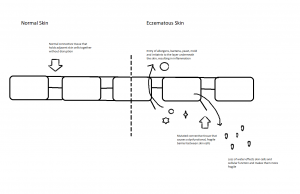
With summer here, many patients are noticing their skin conditions worsen. The dry heat can be an irritating factor for many, flaring their rash. In this, part I of our series on Atopic Dermatitis or Allergic Eczema, we examine what atopic dermatitis is and what causes atopic dermatitis.
What is Atopic Dermatitis?
Atopic dermatitis (AD), the most common type of eczema, appears as a red, itchy rash or dry, scaly plaques of skin. While it can develop at any age, it usually begins in infancy or young childhood.
What causes AD?
Not everything is known about AD but patients with AD tend to have a hyperactive immune system that responds with allergic inflammation. Some patients with AD have a mutation in the connective tissue of the skin that is responsible for holding skin cells together and creating a skin barrier. Without an intact barrier, allergens (substances that cause allergies), irritants, bacteria and viruses can easily enter the area beneath the skin where the cells of inflammation react and water is easily lost, making the skin dry and the patient prone to allergy, inflammation, and infection.

Picture: Normal Skin v. Eczematous Skin
Normal Skin is held together by connective tissue without disruption
Mutated connective tissue, such as that with eczema, causes fragile connections between skin cells, resulting in a dysfunctional skin barrier
Entry of allergens, bacteria, yeast, mold and irritants to the layer underneath the skin results in inflammation
Loss of water from the skin causes loss of cell function and makes the skin layer fragile.
Patients with AD have higher rates of food allergy, environmental allergy and are more likely to develop asthma. Because of the loss of the skin barrier, patients with untreated AD have among the highest rate of increase of allergies. This means that if an allergy test were done at the age of 2 and the age of 20, without skin hydration and care, the allergies would be expected to increase in number far greater than other, non-AD patients. Patients with AD have higher rates of anxiety and depression, thought to be due to an impaired quality of life.
Next in Part II of our series, The SKIN-ny on Atopic Dermatitis and Eczema,….General Care and Hydration of Skin with Atopic Dermatitis and Eczema…. and The Skin-ny on Atopic Dermatitis and Eczema: Part IIb: General Care and Hydration of Skin with Atopic Dermatitis and Eczema, Initial Treatment by you Allergist
If you would like to be tested for your allergies or believe you might be a good candidate for eczema or would just like to understand your skin allergies, Dr. Wendt and her staff at Relieve Allergy, Asthma & Hives would love to help.
Call 480-500-1902 or request an appointment at https://relieveallergyaz.com/contact now! Begin your allergy testing journey with Dr. Wendt at Relieve Allergy in Scottsdale, Arizona—It’s time to take care of yourself!
Learn more about Dr. Wendt and Relieve Allergy Asthma & Hives at www.relieveallergyaz.com or connect with us: https://www.facebook.com/RelieveAllergy/, https://www.linkedin.com/in/julie-wendt/, https://x.com/RelieveAllergy, https://www.instagram.com/relieve_allergy/ or https://www.youtube.com/@JulieWendt-qx7jm
Relieve Allergy Asthma & Hives is located near Kierland Commons, 21803 N. Scottsdale Road Ste. 200, and has convenient evening and morning hours to accommodate your schedule. Dr. Wendt is also available for telemedicine appointments as appropriate. Most insurance plans are accepted.
DISCLAIMER: This blog is not meant to substitute for medical care by an Allergist-Immunologist nor is it intended to provide medical advice or imply a Physician-Patient relationship with its readers or their family. It is intended to provide guidance, direction, and moral support from someone experienced in testing and treating allergies. This is also not meant to be a “do-it-yourself” manual or a “how to” overcome your allergies. Some of the issues mentioned, whether allergic or look-a-like, can be dangerous or if left unchecked, deadly. Please develop a relationship with a Physician you trust to help you with diagnosis, advice, questions, and treatment regarding your and your family’s medical conditions.
Share this post. Choose your platform:
Search Blog & Pages
Recent Posts

